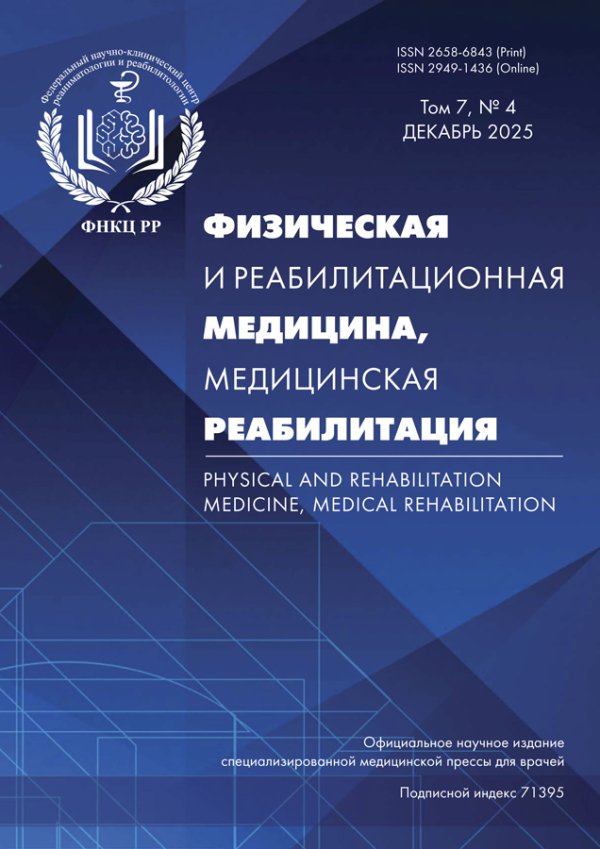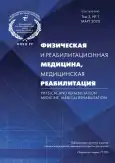Nutritive rehabilitation of the patients after recovering from coma
- Authors: Petrova M.V.1,2, Shestopalov A.E.1,3, Yakovleva A.V.4, Krylov K.Y.1, Mengistu E.M.2
-
Affiliations:
- Federal State Budgetary Scientific Institution "Federal Research and Clinical Center for Resuscitation and Rehabilitology"
- Peoples Friendship University of Russia
- Federal State Budgetary Educational Institution of Further Professional Education "Russian Medical Academy of Continuous Professional Education" of the Ministry of Healthcare of the Russian Federation
- Federal State Budgetary Scientific Institution "Federal Research and Clinical Center for Resuscitation and Rehabilitology
- Issue: Vol 2, No 1 (2020)
- Pages: 28-37
- Section: ORIGINAL STUDY ARTICLE
- URL: https://journal-vniispk.ru/2658-6843/article/view/21185
- DOI: https://doi.org/10.36425/rehab21185
- ID: 21185
Cite item
Full Text
Abstract
Background. Along with the measures to restore the basic body functions and prevent secondary brain injury, one of the key areas of modern rehabilitation is nutritional and metabolic support.
Aims: to improve the results of the treatment of the patients by optimizing the system of nutritional and metabolic rehabilitation using enteral, parenteral, combined parenteral-enteral nutrition methods, who are undergoing rehabilitation after recovering from Coma resulting from injuries and diseases of the central nervous system.
Methods. In a prospective cohort study, the results of the study and complex treatment of 113 patients after recovering from Coma as a result of brain injury of various etiologies who were undergoing rehabilitation in the period from 2017 to 2019 in the FNRC RR were analyzed.
Results. Indirect calorimetry has proven to be the most accurate method for creating an effective and adequate program of nutritional and metabolic support in patients in chronic critical conditions who recovers from the coma. In patients who recovers from the coma, due to the excessive process of hypercatabolism, increasing protein requirements: the average protein requirements for a patient who recovers from the coma are 1.26–1.5 g of protein per kg/weight. Conducting optimal nutritional support for patients recovering from Coma involves determining the functional state of the gastrointestinal tract. To build an effective and adequate program of nutritional and metabolic support where accurate determination of energy needs is of great importance.
Conclusions. The indirect calorimetry method is a valuable tool for assessing energy needs, although without taking into account the functionality of the gastrointestinal tract and other factors affecting body compositions, it may not be sufficient to prescribe optimal nutritional support in patients after recovering from Comatose.
Full Text
##article.viewOnOriginalSite##About the authors
M. V. Petrova
Federal State Budgetary Scientific Institution "Federal Research and Clinical Center for Resuscitation and Rehabilitology"; Peoples Friendship University of Russia
Email: mail@petrovamv.ru
д.м.н., заместитель директора по научно-клинической деятельности
Russian Federation, 25-2, Petrovka street, Moscow,107031; 6, Miklukho-Maklaya street, Moscow, 117198A. E. Shestopalov
Federal State Budgetary Scientific Institution "Federal Research and Clinical Center for Resuscitation and Rehabilitology"; Federal State Budgetary Educational Institution of Further Professional Education "Russian Medical Academy of Continuous Professional Education" of the Ministry of Healthcare of the Russian Federation
Author for correspondence.
Email: ashest@yandex.ru
SPIN-code: 7531-6925
д.м.н., профессор, главный научный сотрудник лаборатории клинического питания и метаболизма
Russian Federation, 25-2, Petrovka street, Moscow,107031; 2/1, Barrikadnaya st., Moscow, 125993A. V. Yakovleva
Federal State Budgetary Scientific Institution "Federal Research and Clinical Center for Resuscitation and Rehabilitology
Email: avyakovleva@fnkcrr.ru
ORCID iD: 0000-0001-9903-7257
младший научный сотрудник лаборатории клинического питания и метаболизма
Russian Federation, 25-2, Petrovka street, Moscow,107031K. Yu. Krylov
Federal State Budgetary Scientific Institution "Federal Research and Clinical Center for Resuscitation and Rehabilitology"
Email: krkerk@gmail.com
ORCID iD: 0000-0002-1807-7546
к.м.н., старший научный сотрудник лаборатории двигательной реабилитации, восстановления глотания и речи
Russian Federation, 25-2, Petrovka street, Moscow,107031E. M. Mengistu
Peoples Friendship University of Russia
Email: krkerk@gmail.com
ординатор 2-го года, кафедра анестезиологии-реаниматологии с курсом реабилитации
Russian Federation, 6, Miklukho-Maklaya street, Moscow, 117198References
- Коновалов А.Н., Лихтерман Л.Б., Потапов А.А. Черепно- мозговая травма. Клиническое руководство в 3-х т. / Под ред. А.Н. Коновалова. — М.: Антидор, 1998−2002. [Konovalov AN, Likhterman LB, Potapov AA. Cherepno-mozgovaya travma. Klinicheskoye rukovodstvo. Ed by A.N. Konovalov. Moscow: Antidor; 1998−2002. (In Russ).]
- Лихтерман Л.Б. Черепно-мозговая травма. — М.: Медицинская газета, 2003. — 356 с. [Likhterman LB. Cherepno-mozgovaya travma. Moscow: Meditsinskaya gazeta; 2003. 356 р. (In Russ).]
- Carney N, Totten AM, O’Reilly C, et.al. Guidelines for the management of severe traumatic brain injury, fourth edition. Neurosurgery. 2017;80(1):6−15. doi: 10.1227/NEU.0000000000001432.
- Белкин А.А., Пирадов М.А., Парфенов А.Л. Инсульты. В кн.: Интенсивная терапия. Национальное руководство / Под ред. Б.Р. Гельфанда, И.Б. Заболотских. 2-е изд., перераб. и доп. — М., 2017. — С. 288−309. [Belkin AA, Piradov MA, Parfenov AL. Insul’ty. In: Intensivnaya terapiya. Natsional’noye rukovodstvo. Ed by B.R. Gel’fand, I.B. Zabolotskikh. 2nd revised and updated. Moscow; 2017. Рр. 288−309. (In Russ).]
- Гринберг М.С. Нейрохирургия / Пер. с англ. М.С. Гельфенбейн. — М.: МЕДпресс-информ, 2010. — 1007 с. [Greenberg MS. Handbook of neurosurgery 5th ed. Transl. from English M.S. Gel’fenbeyn. Moscow: MEDpress-inform; 2010. 1007 p. (In Russ).]
- Guizhen X, Qiuyou X, Yanbin H, et al. Comparing the measured basal metabolic rates in patients withchronic disorders of consciousness to the estimated basal metabolic rate calculated from common predictive equations. Clin Nutr. 2017. doi: 10.1016/j.clnu.2016.09.011.
- Singer P, Anbar R, Cohen J, et al. The tight calorie control study (TICACOS): a prospective, randomized, controlled pilot study of nutritional support in critically ill patients. Intensive Care Med. 2011;37(4):601−609. doi: 10.1007/s00134-011-2146-z.
- Singer P, Blaser AR, Berger MM, et al. ESPEN guideline on clinical nutrition in the intensive care unit. Clin Nutr. 2019;38(1):48−79. doi: 10.1016/j.clnu.2018.08.037.
- Луфт В.М., Афончиков В.С., Дмитриев А.В., и др. Руководство по клиническому питанию / Под ред. профессора В.М. Луфта. 3-е переиздание. — СПб.: Арт-Экспресс, 2016. — 492 с. [Luft VM, Afonchikov VS, Lapitsky AV, Nazarov VE. Guide to clinical food. Ed by V.M. Luft. 3rd revised. St. Petersburg: Art-Ekspress; 2016. 492 р. (In Russ).]
- Basics in clinical nutrition. In: Forth edition, ed. by L. Sobotka. Galen; 2011.
- Sercombe R, Dinh YR, Gomis P. Cerebrovascular inflamation following subarachnoid hemorrhage. Jpn J Pharmacol. 2002;88(3):227−249. doi: 10.1254/jjp.88.227.
- Bansal V, Costantini T, Kroll L, et al. Traumatic brain injury and intestinal dysfunction: uncovering the neuro-enteric axis. J Neurotrauma. 2009;26(8):1353−1359. doi: 10.1089/neu.2008-0858.
- Olsen AB, Hetz RA, Xue H, et al. Effects of traumatic brain injury on intestinal contractility. Neurogastroenterol Motil. 2013;25(7):593-e463. doi: 10.1111/nmo.12121.
- Swidsinski A, Loening-Baucke V, Krüger M, Kirsch S. Central nervous system and the colonic bioreactor: analysis of colonic microbiota in patients with stroke unravels unknown mechanisms of the host defense after brain injury. Intest Res. 2012;10(4):332−334. doi: 10.5217/ir.2012.10.4.332.
Supplementary files












